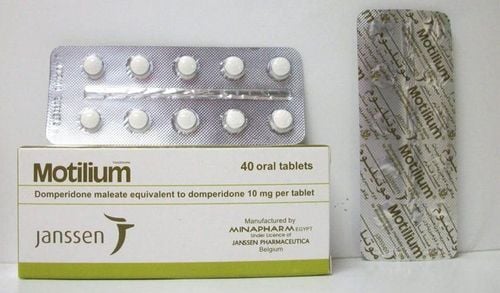This is an automatically translated article.
Cadiperidone is a drug indicated in the treatment of vomiting and nausea, the product should not be used in patients with moderate and severe liver failure or children under 1 year of age. To ensure effective use, users need to follow the instructions of their doctor, and consult more information about the use of Cadiperidone.
1. What are the uses of Cadiperidone?
1.1. What is Cadiperidone? Cadiperidone is a medicine used to treat symptoms such as vomiting and nausea. Cadiperidone drug has the ingredients Domperidone (in the form of Domperidone maleate) 10mg and excipients: Lactose monohydrate; Avicel PH101; Polyvinyl pyrrolidone (PVP) K30; Magnesium stearate; Colloidal silicon dioxide (Aerosil) and Sodium starch glycolate.
The drug is prepared in the form of film-coated tablets and packing: Box with 6 blisters, box of 10 blisters each with 10 tablets. This product is not intended for use in patients with moderate or severe hepatic impairment, or in infants under 1 year of age.
1.2. What is Cadiperidone used for? Indications for Cadiperidone:
Nausea and vomiting, bloating or loss of appetite, indigestion, heartburn, and clear belching. Adults: have chronic gastritis, gastric prolapse, reflux esophagitis, and symptoms after gastrectomy or are taking anticancer drugs or L-dopa; Children: periodic vomiting, upper respiratory infection, taking anticancer drugs. Contraindications of Cadiperidone:
Patients with vomiting after surgery Bleeding in the gastrointestinal tract. Mechanical intestinal obstruction. Children less than 1 year old. Regular or long-term use of Cadiperidone. Patients with moderate and severe liver failure. Patients with prolonged conduction time of cardiac impulses, especially QT interval, patients with marked electrolyte disturbances, or patients with existing cardiovascular disease such as congestive heart failure. Concomitant use with drugs that prolong the QT interval. Concomitant use with drugs that inhibit CYP3A4.
2. Usage of Cadiperidon
2.1. How to take Cadiperidone Should take Cadiperidone before meals. If taken after meals, the drug may be delayed absorption. Patients should take the drug at a fixed time and the maximum duration of treatment should not exceed one week.
2.2. Dosage of the drug Cadiperidone Adults:
Adults and adolescents (age 12 and older, and have a full weight of 35 kg or more). Use 10mg tablets, can be used up to 3 times a day, the maximum dose is 30mg a day
Patients with liver failure:
Cadiperidone is contraindicated in patients with moderate and severe hepatic impairment. No dose adjustment is required for patients with mild hepatic impairment.
Patients with renal impairment:
Due to the prolonged half-life of Cadiperidone in patients with severe renal impairment, if repeated administration of Cadiperidone should be reduced to 1 to 2 times per day and adjusted. The dose depends on the degree of renal impairment.
Handling when missed dose:
It is best for the patient to still take Cadiperidone at the time prescribed by the doctor. Taking the medicine at the right time will ensure the best effect of the medicine. Cadiperidone can usually be taken 1 to 2 hours apart from the time ordered by your doctor. Patients should not take up the missed dose when it is too close to the next dose.
Treatment when overdose:
If an overdose occurs, the patient should immediately notify the doctor, or see the body has abnormal symptoms, the patient needs to go to the hospital for timely treatment.
In urgent cases when Cadiperidone overdose or dangerous manifestations, the patient should immediately call a doctor who can quickly diagnose and treat
3. Notes when using Cadiperidone
Renal impairment The half-life of Cadiperidone is prolonged in patients with severe renal impairment. In case of need for repeated administration, the frequency of administration of Cadiperidone should be reduced to 1 to 2 times per day depending on the degree of renal impairment. The dose can be adjusted if necessary.
Cardiovascular effects Cadiperidone drug component Domperidone prolongs the QT interval on the electrocardiogram. During post-marketing surveillance, there have been very few reports of QT interval prolongation, and torsades de pointes associated with domperidone use. These reports contained confounding risk factors such as electrolyte disturbances, or concomitant medications.
Epidemiological studies have shown that domperidone may increase the risk of serious ventricular arrhythmias, or sudden cardiovascular death. This risk is higher for patients over 60 years of age, in patients taking daily doses greater than 30 mg, and in patients taking concomitant QT-prolonging drugs or CYP3A4 inhibitors. Use domperidone at the lowest effective dose in adults and children.
Pregnancy Cadiperidone is not teratogenic; however, it should not be used in pregnant women unless the potential benefit outweighs the potential.
Lactation Cadiperidone is excreted in breast milk and nursing infants receive less than 0.1% of the maternal weight-based dose. Adverse effects, especially cardiovascular effects, are still possible after breastfeeding.
4. Side effects of the drug Cadiperidone
Extrapyramidal disturbances and somnolence occur at a very low rate, usually due to disturbances in the permeability of the blood-brain barrier (premature infants and meningeal lesions) or from overdose. Because the pituitary gland is outside the blood-brain barrier, the drug may further increase blood levels of prolactin. In these rare cases, an increase in prolactin in the blood can cause neuroendocrine phenomena such as gynecomastia and abnormal lactation.
Cardiovascular disorders: Not known: ventricular arrhythmias, and QT interval prolongation, torsades de pointes, or sudden cardiovascular death.
5. Cadiperidone drug interactions
Antiarrhythmic drugs of class IA. Such as: disopyramide; hydroquinidine, and quinidine. Antiarrhythmic drugs of class III such as: amiodarone; dofetilide, and dronedarone; ibutilide; sotalol. Some antipsychotics such as: haloperidol; pimozide, and sertindole. Some antidepressant drugs such as: citalopram; escitalopram. Some antibiotics such as: erythromycin; levofloxacin; moxifloxacin, and spiramycin. Some antifungal drugs such as: pentamidine. Certain antimalarial drugs, especially halofantrin, and lumefantrine. Gastrointestinal drugs such as: cisapride; dolasetron; prucalopride. Antihistamines such as: mequitazine, and mizolastine Some drugs used to treat cancer such as: tamoxifen; vandetanib; vincamine. Other drugs such as: bepridil; diphemanil; methadone. In addition to the information about the use of Cadiperidone, if you have any other questions, you should directly discuss with your doctor for advice and appropriate indications.
Please dial HOTLINE for more information or register for an appointment HERE. Download MyVinmec app to make appointments faster and to manage your bookings easily.













